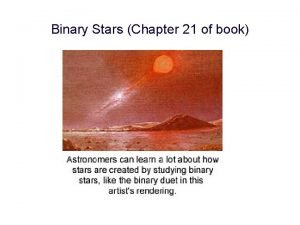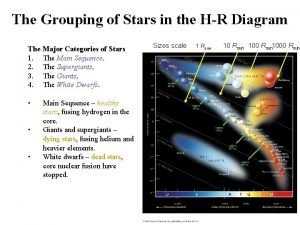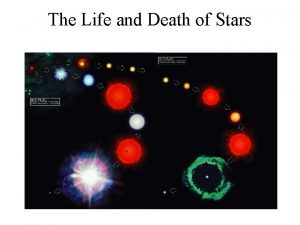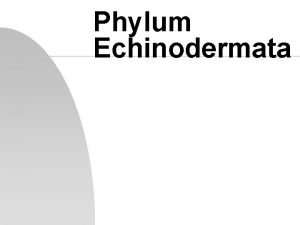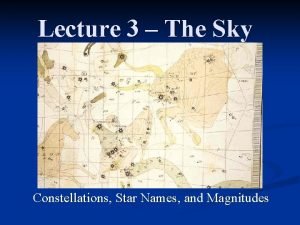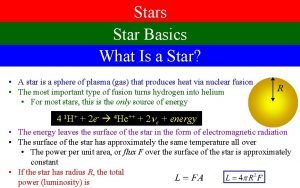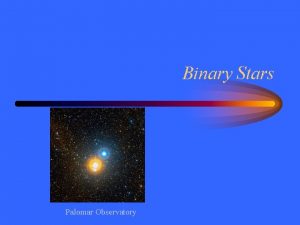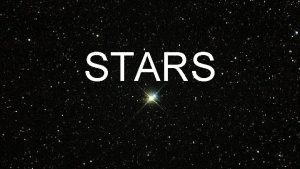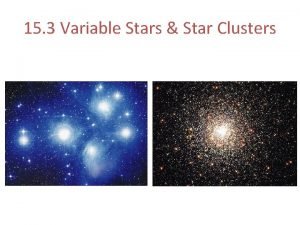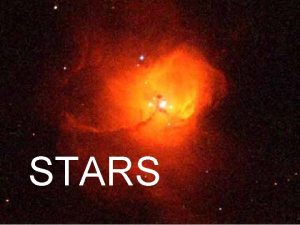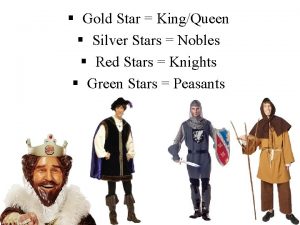STARS What Are Stars A star is a
















- Slides: 16

STARS

What Are Stars? A star is a sphere that is held together by the force of gravity. It is sometimes seen from earth but it is very small because the distance is very far from a solar system to another.

The Life Cycle of A Star

Birth Actually a star’s life cycle is almost the same as human life cycle. First it is born which is called protostar. When the protostar is old enough it will begin fusing hydrogen into helium. The star will start the main sequence or the star will be entering adulthood.

Growing Up (main sequence) Small red dwarf stars are dim stars that fuse hydrogen at slow and small rate. Many stars remain in the main sequence for hundred billion years. Medium stars which are called yellow dwarfs like our sun will remain in the main sequence for several billion years. Big sized stars will only remain in the main sequence for a few million years. This is caused by the amount of hydrogen each star is fusing. When a star is fusing very quickly and if it is in high rate it will run out of energy quicker than stars that are small and fuse at slow and small rate. Medium size star will fuse at medium rate and will run out of energy slower than a big star but faster than a small star.

Maturity Eventually a star will run ot of hydrogen fuel and will start fusing with helium and other gases and elements. At this point it will leave it’s main sequence phase. A star that is small will use up all their hydrogen and will directly collapes into a white dwarf. Middle sized stars like the sun will turn into red giants. Big sized stars will turn into a red supergiant. This happens when a star runs out of hydrogen at its core. The core will collapse and begin fusing helium while hydrogen fusion is transferred to the outer layers. This causes the star to swell to many times its original size and become cooler as the heat is distributed over a larger area. More massive stars will grow into supergiants, which are among the largest stars in the Universe. In this stage a star will maintain hydrostatic equilibrium by fusing heavier and heavier elements as the lighter ones run out. The largest stars can produce elements up to iron.

Death and Stellar Remnants Medium-sized stars like our Sun will eventually die by shedding their outer layers as a planetary nebula. The core will collapse into a white dwarf, which will eventually cool into a black dwarf. More massive stars will die in a tremendous explosion called a supernova. This happens when a massive stars begins to fuse iron. This absorbs energy and caused the core to violently collapse while the outer layers are ejected. The extreme heat produced by supernovae is responsible for the nucleosynthesis of elements heavier than iron, up to uranium. After the supernova the core can compress into a neutron star or a black hole.

Diagram

Different Kinds of Star and Its Size

Sun • Diameter : 1, 390, 000 • Mass : 1, 989 e 30 kg • Temperature : 5, 800 k (surface) 15, 600, 000 K (core) Even though sun is considered big and huge it is stil a medium sized star. There are many other stars that is almost 10 times our sun.

R. Doradus • Diameter : 0. 057 arcsecond • Mass : 1. 2 solar mass • Temperature : 2, 740 ± 190 K Its distance from Earth is 178 ± 10 lihght years. Having a uniform disc diameter of 0. 057 ± 0. 005 arc second. It is currently believed to be the star with the second largest apparent size as viewed from Earth (right after the Sun). The estimated diameter of R Doradus is 515 ± 70 million km or 370 ± 50 times the diameter of the Sun. If placed at the centre of the Solar System, the orbit of Mars and most of the main asteroid belt would be contained within the star.

VY Canis Majoris • • Diameter : 6. 6 astronomical units), about 1, 975, 000 kilometres Mass : 17 ± 8 m Temperature : ~3, 490 K VY Canis Majoris (VY CMa) is a red hypergiant in the constellation Canis Major. It is one of the largest known stars by radius. It is approximately 1, 420 ± 120 solar radii (6. 6 astronomical units), about 1, 975, 000 kilometres 1. 2 kiloparsecs (3, 900 lightyears) distant from Earth. VY CMa is a single star categorized as a semiregular variable and has an estimated period of 2, 000 days. If placed at the center of the Solar System, VY Canis Majoris's surface would extend beyond the orbit of Jupiter although there is still considerable variation in estimates of the radius, with some making it larger than the orbit of Saturn.

Types Of Stars

Diagram

Interesting Facts v The oldest star discovered is HE 1523 -0901, which is estimated 13. 2 billion years old. v Some stars are 600, 000 times brighter than our sun. v 65% of all stars are actually doubled stars. v The closest star to earth is Proxma Centauri (except sun), is located 4. 2 light years away. v The second closest star to Earth is Barnard star that is 6 light years away. v There are 250 billion stars in the milky way galaxy.

Bibliography • THE LIFE CYCLE OF STARS http: //www. enchantedlearning. com/subjects/astronomy/s tars/lifecycle/ • THE LIFE CYCLE OF A STAR • http: //www. telescope. org/pparc/res 8. html • The Sun http: //nineplanets. org/sol. html • R. Doradus http: //en. wikipedia. org/wiki/R_Doradus 14 September 2012 • VY Cnais Majoris http: //en. wikipedia. org/wiki/VY_Canis_Majoris 15 September 2012
 Mikael ferm
Mikael ferm Star of wonder star of night star of royal beauty bright
Star of wonder star of night star of royal beauty bright There are three sizes of schnauzer dog
There are three sizes of schnauzer dog Ao* algorithm
Ao* algorithm Fccla star stands for
Fccla star stands for How did tycho brahe and kepler employ the scientific method
How did tycho brahe and kepler employ the scientific method Stars douglas
Stars douglas Coach pitch all stars
Coach pitch all stars Watching and seeing shooting stars on a dark night
Watching and seeing shooting stars on a dark night Standard candle
Standard candle Figurative language in counting stars
Figurative language in counting stars The stars and i chapter 21
The stars and i chapter 21 Grouping of stars
Grouping of stars The life and death of stars
The life and death of stars Radial canal sea star
Radial canal sea star Description of stars
Description of stars Why do stars form
Why do stars form











